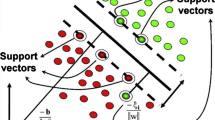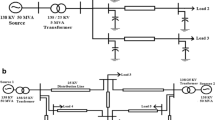Abstract
Fault location methods help to reduce outage time and improve reliability indices and therefore are important in practice. However, the performance of traditional fault location methods which are mainly developed for transmission grid is challenged by the specification and complexities of the distribution grid. Furthermore, the errors in measurement devices compromise the accuracy of the fault localization. This paper addresses these issues through an integrated methodology. In the proposed methodology, current transformer (CT) and potential transformer (PT) errors are first applied to current and voltage data recorded at the starting point of the feeder. Then, the impedance-based fault location method (IBFLM) is used to locate possible fault locations using the recorded voltage and current. Then, at the section of possible points, some locations are selected, the same fault is simulated, and an online databank is generated. After this, using a combination of the wavelet transform, Fourier transform and minimum redundancy maximum relevance (mRMR) algorithm, some features are selected and they can be separated using support vector machine (SVM) classifier. They are utilized to select one point as the final fault location among possible locations. A real feeder is considered as the sample distribution network to assess the performance of the proposed method. Instrument errors are modeled using the Gaussian stochastic process which is added to recorded signals at the starting point of the feeder. The accuracy of the proposed method is investigated under different fault locations, fault resistances, and fault inception angles. Simulation results confirm that the proposed method is highly accurate. The proposed method is tested in a distribution network in a power system simulator in the power system laboratory of Persian Gulf University. The experimental results confirm that the accuracy and precision of the proposed method are high. The method is also compared with other state-of-the-art methods, and the results show a clear improvement.











Similar content being viewed by others
Abbreviations
- \(\Phi\) :
-
Scaling function
- \(\Psi\) :
-
Wavelet functions
- \(h_{\Phi }\) :
-
Digital low-pass filter
- \(h_{\Psi }\) :
-
Digital high-pass filter
- \(W_{\Phi }\) :
-
Approximation coefficients
- \(W_{\Psi }\) :
-
Detailed coefficients
- X j :
-
Fourth level approximation coefficients of the jth fault signal
- M j :
-
Magnitude of Fourier transform of the jth fault signal
- L :
-
Vector of training samples label
- S * :
-
Selected features using mRMR
- Y j :
-
MRMR feature of the jth fault signal
- I(.;.):
-
Mutual Information
- R(.):
-
Redundancy measure
- D(.,.):
-
Relevance measure
- \({{\varvec{\Phi}}}\) :
-
Mapping function of SVM kernel
- \(K\) :
-
Kernel Function
- \(\alpha_{i}\) :
-
Weight of ith support vector
- x actual :
-
Real fault location
- x calculated :
-
Fault location obtained from simulation
- l t :
-
Total length of the feeder
References
Morales JA, Orduña E, Rehtanz C, Cabral RJ, Bretas AS (2016) Ultra high speed deterministic algorithm for transmission lines disturbance identification based on principal component analysis and Euclidean norm. Int J Electr Power Energy Syst 80:312–324
Krishnananda KR, Dasha PK, Naeemb MH (2015) Detection, classification, and location of faults in power transmission lines. Int J Electr Power Energy Syst 67(1):76–86
Zidan A, El-Saadany EF (2015) Incorporating customers’ reliability requirements and interruption characteristics in service restoration plans for distribution systems. Energy 87:192–200
Esmaeeli M, Kazemi A, Shayanfar HA, Haghifam MR (2015) Multistage distribution substations planning considering reliability and growth of energy demand. Energy 84:357–364
Dashti R, Sadeh J (2014) Accuracy improvement of impedance based fault location method for power distribution network using distributed-parameter line model. Int Trans Electr Energy Syst 24(3):318–334
Sadeh J et al (2013) A new fault location algorithm for radial distribution systems using modal analysis. Electr Power Energy Syst 45(1):271–278
Oliveira KRC et al (2007) Unbalanced underground distribution systems fault detection and section estimation. In: Huang DS, Heutte L, Loog M (eds) Advanced intelligent computing theories and applications with aspects of artificial intelligence lecture notes in computer science. Springer, Berlin, pp 1054–1065
Kezunovic M, Liao Y (2001) Fault location estimation based on matching the simulated and recorded waveforms using genetic algorithms. IEE Conf Power Syst Prot 479:399–402
Mora-Florez J et al (2009) K-means algorithm and mixture distributions for locating faults in power systems. Electr Power Syst Res 79(5):714–721
J. Mora-Florez et al. (2008) Selection of Currents Patterns Using SVMs for Locating Faults in Radial Power Systems. In: IEEE/PES Transmission and distribution conference and exposition: Latin America, pp. 1–7
Lee SJ et al (2004) An intelligent and efficient fault location and diagnosis scheme for radial distribution systems. IEEE Trans Power Deliv 19(2):524–532
Morales-España G et al (2009) Elimination of multiple estimation for fault location in radial power systems by using fundamental single-end measurements. IEEE Trans Power Deliv 24(3):1382–1389
Dashti R, Sadeh J (2013) Applying dynamic load estimation and distributed parameter line model to enhance the accuracy of impedance based fault location methods for power distribution networks. Electr Power Compon Syst J 14(1):1334–1362
Salim RH et al (2011) Further improvements on impedance based fault location for power distribution systems. IET Gener Trans Distrib 5(4):467–478
Das R (1998) Determining the locations of faults in distribution systems", Ph.D. Thesis, College of Graduate Studies and Research, University of Saskatchewan, Saskatchewan
Nouri H, Wang C, Davies T (2001) An accurate fault location technique for distribution lines with tapped loads using wavelet transform. In: IEEE power technology conference proceedings, porto, pp. 10–13
Dashti R, Sadeh J (2013) Applying dynamic load estimation and distributed-parameter line model to enhance the accuracy of impedance-based fault-location methods for power distribution networks. Electr Power Compon Syst J 14(1):1334–1362
Arya A et al. (2010) Evolving non-dominated solutions in multi objective fault section estimation for automated distribution networks. In: International conference on power system technology (POWERCON)
Daisy M, Dashti R (2016) Single phase fault location in electrical distribution feeder using hybrid method. Energy 103:356–368
Adewole AC et al (2016) Distribution network fault section identification and fault location using wavelet entropy and neural networks. Appl Soft Comput 46:296–306
Shafiullah Md et al (2017) Wavelet-based extreme learning machine for distribution grid fault location. IET Gener Trans Distrib 11(17):4256–4263
Dashti R, Daisy M, Shaker HR, Tahavori M (2018) Impedance-based fault location method for four-wire power distribution networks. IEEE Access 6:1342–1349
Dashti R, Sadeh J (2014) Fault section estimation in power distribution network using impedance-based fault distance calculation and frequency spectrum analysis. IET Gener Transm Distrib 8(8):1406–1417
Salim RH et al (2009) Extended fault-location formulation for power distribution systems. IEEE Trans Power Deliv 24(2):508–517
Mei N et al. (2007) A matrix-based fault section estimation algorithm for complex distribution systems. In: UPEC 2007, pp. 284–289
Spoor D, Zhu JG (2006) Improved single-ended traveling-wave fault-location algorithm based on experience with conventional substation transducers. IEEE Trans Power Deliv 21(3):1714–1720
Spoor D, Zhu JG (2006) Improved single-ended traveling-wave fault location algorithm based on experience with conventional substation transducers. IEEE Trans Power Deliv 21(3):1714–1720
Shaik AG, Pulipaka RRV (2015) A new wavelet based fault detection, classification and location in transmission lines. Int J Electr Power Energy Syst 64:35–40
Chanda D, Kishore NK, Sinha AK (2003) A wavelet multiresolution analysis for location of faults on transmission lines. Int J Electr Power Energy Syst 25(1):59–69
Xie L, Luo L, Li Y, Zhang Y, Cao Y (2020) A traveling wave-based fault location method employing VMD-TEO for distribution network. IEEE Trans Power Deliv 35(4):1987–1998. https://doi.org/10.1109/TPWRD.2019.2959188
Shi S, Zhu B, Lei A, Dong X (2019) Fault location for radial distribution network via topology and reclosure-generating traveling waves. IEEE Trans Smart Grid 10(6):6404–6413. https://doi.org/10.1109/TSG.2019.2904210
Liang J, Jing T, Niu H, Wang J (2020) Two-terminal fault location method of distribution network based on adaptive convolution neural network. IEEE Access 8:54035–54043. https://doi.org/10.1109/ACCESS.2020.2980573
Dashti R, Daisy M, Shaker HR, Tahavori M (2018) Impedance-based fault location method for four-wire power distribution networks. IEEE Access 6(1):1342–1349
Dashti R, Ghasemi M, Daisy M (2018) Fault location in power distribution network with presence of distributed generation resources using impedance based method and applying line model. Energy 159(1):344–360
Goudarzi M, Vahidi B, Naghizadeh RA, Hosseinian SH (2015) Improved fault location algorithm for radial distribution systems with discrete and continuous wavelet analysis. Int J Electr Power Energy Syst 67(1):423–430
Wang C, Yun Z (2019) Parameter-free fault location algorithm for distribution network T-type transmission lines. Energies 12(8):1–17
Gururajapathy SS, Mokhlis H, Illias HA (2019) Fault location using mathematical analysis and database approach. COMPEL-Int J Comput Math Electr Electron Eng 38(1):415–430
Aboshady FM, Thomas DW, Sumner M (2019) A new single end wideband impedance based fault location scheme for distribution systems. Electr Power Syst Res 173(1):263–270
Gord E, Dashti R, Najafi M, Shaker HR (2019) Real fault section estimation in electrical distribution networks based on the fault frequency component analysis. Energies 12(6):1–29
Deng X, Yuan R, Xiao Z, Li T, Wang KL (2015) Fault location in loop distribution network using SVM technology. Int J Electr Power Energy Syst 65(1):254–261
De Aguiar RA, Dalcastagnê AL, Zürn HH, Seara R (2018) Impedance-based fault location methods: sensitivity analysis and performance improvement. Electr Power Syst Res 155(1):236–245
Mirshekali H, Dashti R, Keshavarz A, Torabi AJ, Shaker HR (2020) A novel fault location methodology for smart distribution networks. IEEE Trans Smart Grid 12(2):1277–1288
Bugata P, Drotar P (2020) On some aspects of minimum redundancy maximum relevance feature selection. Sci China Inf Sci 63:112103. https://doi.org/10.1007/s11432-019-2633-y
Mellat E (2009) A wavelet tour of signal processing: the sparse way. Elsevier, Amsterdam
Cortes C, Vapnik V (1995) Support-vector network. Mach Learn 20:273–297
Platt J (1999) Probabilistic outputs for support vector machines and comparisons to regularized likelihood methods. Adv Large Margin Classif 10(3):61–74
Lin HT, Lin CJ, Weng RC (2007) A note on Platt’s probabilistic outputs for support vector machines. Mach Learn. https://doi.org/10.1007/s10994-007-5018-6
Mokhlis H, Li H (2011) Non-linear representation of voltage sag profiles for fault location in distribution networks. Int J Electr Power Energy Syst 33(3):124–130
Mokhlis H, Khalid AR, Li HY (2009) Voltage sags pattern recognition technique for fault section identification in distribution networks. In: PowerTech 2009; IEEE bucharest; pp. l–6
Choi MS, Lee SJ, Lee DS, Jin BG (2004) A new fault location algorithm using direct circuit analysis for distribution systems. IEEE Trans Power Deliv 19(1):35–41
Borghetti A, Boseti M (2008) Continuous-wavelet transform for fault location in distribution power networks: definition of mother wavelets inferred from fault originated transients. IEEE Trans Power Syst 23(2):380–388
Acknowledgements
This work is supported by the “Smart Fault Prediction and Location for Distribution Grids” project, funded by the Danish Energy Agency under the Energy Technology Development and Demonstration Program, ID number: 64019-0592.
Author information
Authors and Affiliations
Corresponding author
Ethics declarations
Conflict of interest
The authors declare no conflict of interest.
Additional information
Publisher's Note
Springer Nature remains neutral with regard to jurisdictional claims in published maps and institutional affiliations.
Rights and permissions
About this article
Cite this article
Keshavarz, A., Dashti, R., Deljoo, M. et al. Fault location in distribution networks based on SVM and impedance-based method using online databank generation. Neural Comput & Applic 34, 2375–2391 (2022). https://doi.org/10.1007/s00521-021-06541-2
Received:
Accepted:
Published:
Issue Date:
DOI: https://doi.org/10.1007/s00521-021-06541-2




